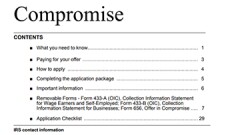“Settle Your Back Taxes for a Fraction of What You Owe - Tax Evaluation Waiting! Stop IRS Collections Now.”
--Google search ad results, September 2018
What’s true is that the IRS has a program that allows taxpayers to settle their tax debts for less than the amount they owe. The formal name for this tax debt settlement program is the IRS Offer in Compromise.
That brings us to what’s false.
Despite ads that imply the OIC is a common and reasonable solution for many people, the reality is that few people qualify for this program. In fact, while more than 16 million people and 3 million businesses owe the IRS, only 25,000 settled their tax debts using the OIC last year.
The reason is simple: From the IRS perspective, most taxpayers can afford to pay their taxes with their current assets or over time or with a payment plan — so those people wouldn’t qualify for an OIC. Every year, millions of taxpayers pay their taxes on monthly payment plans.
The OIC program is geared toward a narrow segment of taxpayers — people who will never be able to pay all of the debt with their future income or assets before the IRS runs out of time to collect it (generally, 10 years from the date the tax was assessed). For most people, there are IRS alternatives to the OIC that work out much better for their situation.
Next year, it will be more important than ever for taxpayers to understand their IRS payment options. In 2019, the IRS projects that 3 to 4 million new taxpayers (on top of the 30 million who already file with a balance due) will owe taxes due to tax reform and a growing gig economy. These basics will help taxpayers choose the right option with the IRS.



















